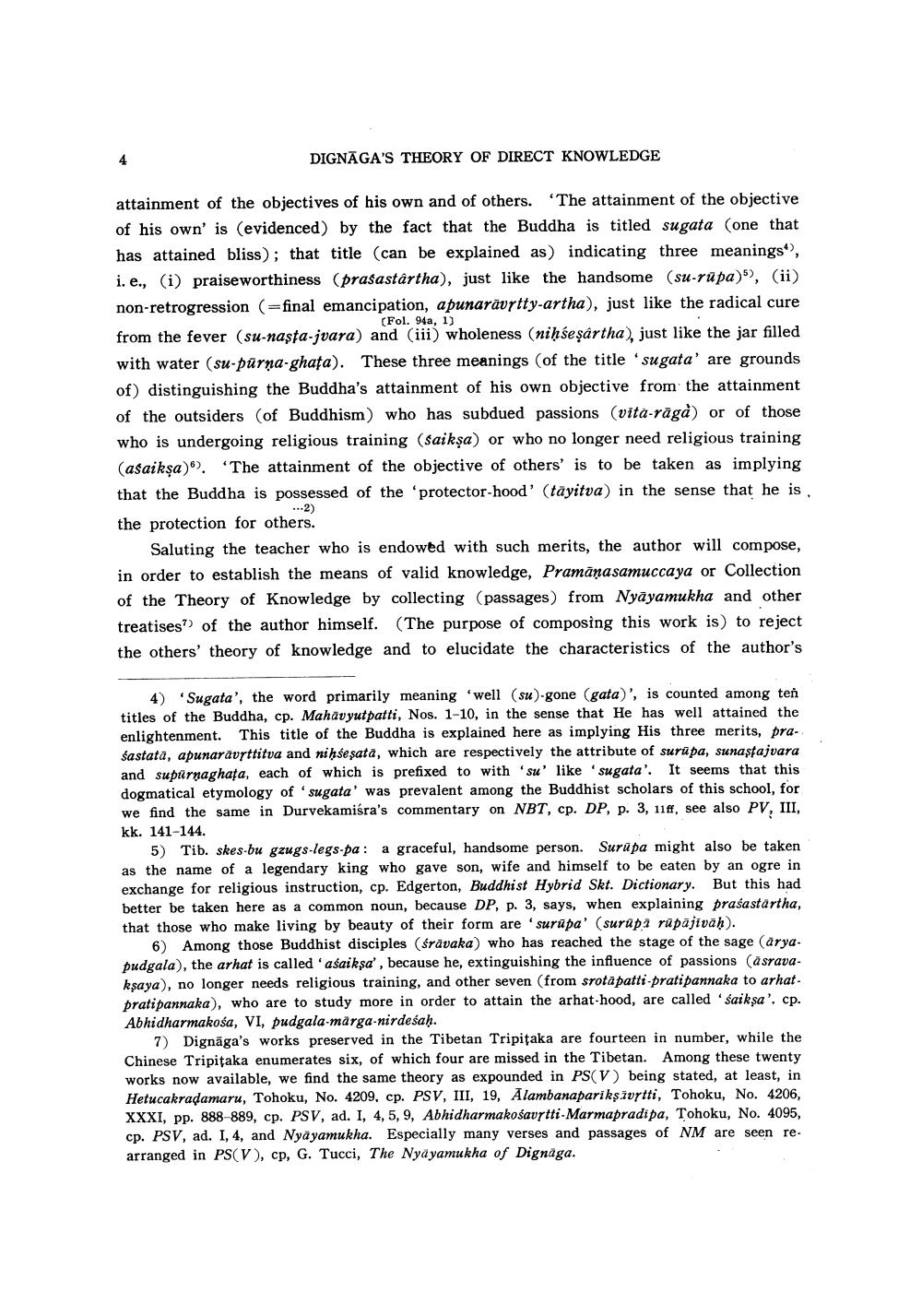Book Title: Dignagas Theory Of Direct Knowledge Author(s): Massaki Hattori Publisher: Massaki Hattori View full book textPage 4
________________ DIGNAGA'S THEORY OF DIRECT KNOWLEDGE (Fol. 94a, 1) attainment of the objectives of his own and of others. "The attainment of the objective of his own' is (evidenced) by the fact that the Buddha is titled sugata (one that has attained bliss); that title (can be explained as) indicating three meanings"), i.e., (i) praiseworthiness (prasastartha), just like the handsome (su-rupa)5), (ii) non-retrogression (=final emancipation, apunaravrtty-artha), just like the radical cure from the fever (su-nasta-jvara) and (iii) wholeness (nihsesartha), just like the jar filled with water (su-purna-ghata). These three meanings (of the title 'sugata' are grounds of) distinguishing the Buddha's attainment of his own objective from the attainment of the outsiders (of Buddhism) who has subdued passions (vita-raga) or of those who is undergoing religious training (saiksa) or who no longer need religious training (asaiksa)6). "The attainment of the objective of others' is to be taken as implying that the Buddha is possessed of the 'protector-hood' (tayitva) in the sense that he is, the protection for others. Saluting the teacher who is endowed with such merits, the author will compose, in order to establish the means of valid knowledge, Pramanasamuccaya or Collection of the Theory of Knowledge by collecting (passages) from Nyayamukha and other treatises of the author himself. (The purpose of composing this work is) to reject the others' theory of knowledge and to elucidate the characteristics of the author's ...2) 4) 'Sugata', the word primarily meaning 'well (su)-gone (gata)', is counted among ten titles of the Buddha, cp. Mahavyutpatti, Nos. 1-10, in the sense that He has well attained the enlightenment. This title of the Buddha is explained here as implying His three merits, prasastata, apunaravyttitva and nihsesata, which are respectively the attribute of surupa, sunastajvara and supurnaghata, each of which is prefixed to with 'su' like 'sugata'. It seems that this dogmatical etymology of 'sugata' was prevalent among the Buddhist scholars of this school, for we find the same in Durvekamisra's commentary on NBT, cp. DP, p. 3, 11ff, see also PV, III, kk. 141-144. 5) Tib. skes-bu gzugs-legs-pa: a graceful, handsome person. Surupa might also be taken as the name of a legendary king who gave son, wife and himself to be eaten by an ogre in exchange for religious instruction, cp. Edgerton, Buddhist Hybrid Skt. Dictionary. But this had better be taken here as a common noun, because DP, p. 3, says, when explaining prasastartha, that those who make living by beauty of their form are 'surupa' (surupi rupajivah). 6) Among those Buddhist disciples (sravaka) who has reached the stage of the sage (arya. pudgala), the arhat is called 'asaiksa', because he, extinguishing the influence of passions (asrava. ksaya), no longer needs religious training, and other seven (from srota patti-prati pannaka to arhatprati pannaka), who are to study more in order to attain the arhat-hood, are called 'saiksa'. cp. Abhidharmakosa, VI, pudgala-marga-nirdesah. 7) Dignaga's works preserved in the Tibetan Tripitaka are fourteen in number, while the Chinese Tripitaka enumerates six, of which four are missed in the Tibetan works now available, we find the same theory as expounded in PS(V) being stated, at least, in Hetucakradamaru, Tohoku, No. 4209, cp. PSV, III, 19, Alambanapariksavrtti, Tohoku, No. 4206, XXXI, pp. 888-889, cp. PSV, ad. I, 4, 5, 9, Abhidharmakosavytti-Marmapradipa, Tohoku, No. 4095, cp. PSV, ad. I, 4, and Nyayamukha. Especially many verses and passages of NM are seen rearranged in PS(V), cp, G. Tucci, The Nyayamukha of Dignaga.Page Navigation
1 2 3 4 5 6 7 8 9 10 11 12 13 14 15 16 17 18 19 20
